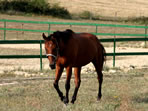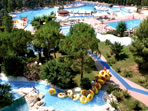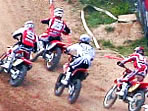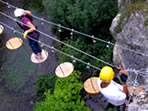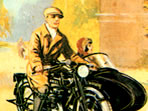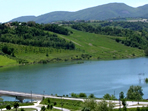Castles and fortresses
THE RANCIA CASTLE
The Rancia Castle owes its name to the ancient granary - named “grancia” after the latin “granica” and the French “grange”- used by the Cistercian monks of Fiastra Abbey at the end of the XII century. For defence reasons the farm was already provided with a donjon, probably originally made of wood, as wheat depots were the first target to be destroyed in case of attack.
The building was turned into a fortress between 1353 and 1357 by the architect Andrea Beltrami da Como by order of Rodolfo II da Varano from Camerino, who was aware of the strategic and military potential of the depot.
When the Jesuits took possession of the Fiastra Abbey in 1581, the Castle lost its military connotations and was restructured as a big farm and used to host pilgrims on their way to Rome. 1782 pope Pio VI came to Tolentino and granted all the possessions of Fiastra Abbey, including the Castle, to the noble family Bandini. The last descendant, Maria Sofia Gravina di Ramacca, in 1974 gave the Castle to the Municipality of Tolentino, who is the actual owner.
Many important events took place here; the most important was the battle fought May 2 and 3, 1815 between the French army led by Gioacchino Murat and the Austrian army led by the General Federico Bianchi, hosted in Parisani-Bezzi Palace, now called Napoleonic Museum.
The battle of Tolentino 1815 has been regarded as the prologue of Waterloo and the first battle of the Italian Risorgimento (the so called “Resurgence”).
GRADARA CASTLE
Gradara stands like a green island among the sweet Marche hills at an altitude of 142 meters above sea level. It is even possible to smell the sea’s salty odor, because it is only three kilometers away.
Gradara Castle is a fairy-like place with an ancient taste. Here, legend clings to history and they tell of the tragic love affair between Paolo and Francesca celebrated by Dante, Petrarca, Boccaccio and D'Annunzio.
Gradara boasts a remarkable artistic patrimony which makes its cultural even more precious. In fact, in Gradara valuable pictures and beautiful frescoes can be admired. But its most important artistic work is a magnificent terracotta altar-piece, attributed to Andrea della Robbia, which is held in the castle chapel.
Lovers who stroll along its streets, especially at night, under the well lightened fortress surrounded by ancient oaks, live in a romantic unique frame in which love, poetry and history melt with a wonderful landscape.
The Gradara Castle was built between the 11th and 15th centuries and was the scene of continuing conflict between the Malatesta and Montefeltro families before falling under control of the Sforza family. However its place in history has been secured thanks not so much to these warring families but to the great poet Dante. In the Divine Comedy, in the fifth Canto in the Inferno, he recounts the tragic love affair between Paolo and Francesca, which stands as a timeless symbol for generations of lovers.
Their passionate affair took place here at Gradara Castle and their chamber in the castle still has a melancholy atmosphere which remains just as poignant today.
THE PALLOTTA CASTLE
The Pallotta Castle makes the whole town to look unforgettable: from the top of the hill it dominates with the armony of a Renaissance building, which has replaced the modest dwellings where once a feudal castle stood. We do not have any precise news about the castle's origins. The entrance is through Porta Camerte closed by a massive gate.
Once you have passed by the first courtyard with the communication-trenches, the portcullis at closure of the entrance and the machicolation, you find yourself in a rather dark hall; in the left lobby you can admire a 1845 fresco. From the hall you enter into an room where the carriages, the harnesses and the arms are kept. By crossing the draw-bridge you get into the park, where one of the oldest pinetree of the region stands high.
On the main floor, among the numerous fully furnished rooms, the dining-room is the most interesting: it houses a rich eighteenth-century pottery and Bohemia crystals collection.
ROCCA DI AIELLO A CAMERINO
Rocca d'Ajello is an ancient fortress of the Varano family, lords of the duchy of Camerino between the XIIIth and XVIth century. It is located on a woody hill about 6 miles from Camerino and 30 from Macerata. The two towers were built by Gentile I da Varano around 1260. Giulio Cesare Varano in 1450 added a U shaped building to use the fortress as a villa.
Today the castle is privately owned and can be rented to organize weddings and events.
ROCCA DI MONDAVIO
The Fortress was built between 1482 & 1492 commissioned by Giovanni della Rovere who was Lord of Senigallia and of the Vicarage of Mondavio. He was the son-in-law of Federico of Montefeltro.
It was designed by Francesco di Giorgio Martini, creator of the architectural defensive system of Urbino under the Monfeltro family. The Rocca of Mondavio is considered an absolute masterpiece of the Renaissance military architecture.
ROCCA DI OFFAGNA
This is a small town where you can’t miss the big Renaissance fortress, maybe the best example of military fortification in the Marche region. It has been kept in a good state and it hosts inside the Museum of ancient weapons.
In addition the Mount of Piety, the church of the Most Holy Sacrament by Vanvitelli and the Paolucci Museum are worth visiting. Here you find paleontological, mineralogical, zoological and botany collections which include unique remains of inexistent species nowadays and which are essential to understand the evolution of our territory.






